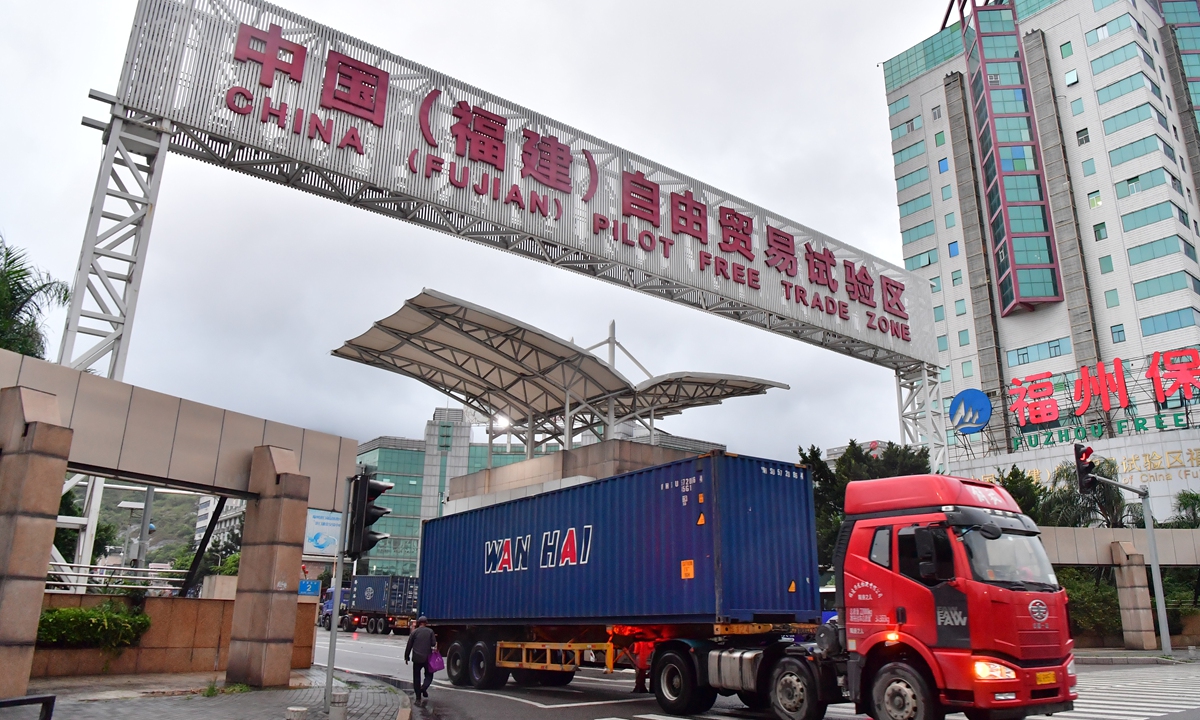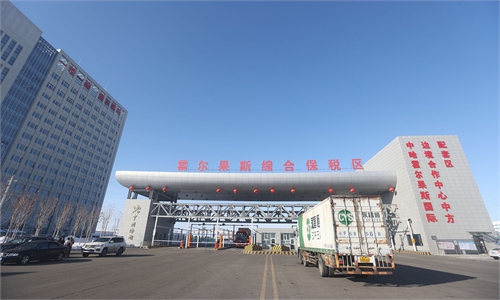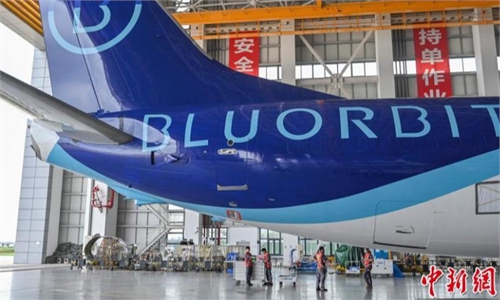China's pilot free trade zones boost innovative reform with progress made in chips and other key sectors

A truck drives through the front entrance of China (Fujian) Pilot Free Trade Zone in East China's Fujian Province, on August 11, 2022. Photo:cnsphoto
As 2023 marks the 10th anniversary for China launching the pilot free trade zones (FTZs), the current 21 established ones have played an indispensable role in exploring new paths for the nation's comprehensively deepening reform and promoting the high-quality opening-up.
Located in Guangzhou, the capital of Guangdong Province, Nansha is a major base for the Guangdong Pilot Free Trade Zone. Amid the stringent unilateral restrictions imposed by the US and its allies on China for obtaining chip manufacturing equipment and raw materials, Nansha has become a significant hub for empowering China's innovation in the semiconductor industry.
Nansha is just a snapshot of how China's pilot free trade zones (FTZs) have been contributing to boost the nation's innovation, covering sectors from chips to the internet.
Solid backing for chips
When visiting a local semiconductor enterprise, AccoPower, which produces silicon carbide (SiC) power devices, on July 2, the Global Times learned that the company's main products, including automotive-grade power modules and industrial-grade power modules, are widely used in multiple sectors including photovoltaic, wind energy, and energy storage and have also been exported to the Europe and adapted by multiple NEV models such as the Smart from Mercedes Benz.
In 2021, AccoPower established a subsidiary dedicated to 6-inch and 8-inch SiC chip production , which will offer core chips to the new-energy field while its series of products forming a whole industrial chain and ecology for the third-generation semiconductor industry, according to the company.
"Chinese enterprises have a relatively small gap in the third-generation semiconductor field, and we hope to catch up and even to reach the international leading level," Liu Cheng, an official from Nansha district's industry and information technology bureau in South China's Guangdong Province, told the Global Times.
Nansha has the most important industrial base for new-energy vehicles (NEVs) in Guangdong, which provides a good foundation for deepening the integration of NEVs with the third-generation semiconductor industry, according to Liu.
Liu added that Nansha is currently stepping up policy support for the third-generation semiconductors, while vigorously developing research and development for advanced semiconductor industry and clusters targeting the core components of NEVs and artificial intelligence (AI).
Nansha has already issued nine measures to stimulate the local development of semiconductor and integrated circuits. At present, Guangzhou has built an industrial park covering an area of about 1.97 square kilometers targeting the integrated circuit sector, basically covering the manufacturing from the upstream to the downstream application end while completing the initial formation of the ecology.
Smart construction
In addition to Nansha, the advancements of the smart logistics in the Xiamen area and the Internet of Things (IoT) industry in the Fuzhou area of the Fujian Pilot FTZ in East China are also representative examples, further benefiting the operation of local businesses.
The Xiamen International Trade Single Window, a major public service platform jointly launched by 11 government departments, has offered enterprises with a convenient one-stop window to handle multiple customs and port-related service at once.
The construction of the trade single window has adapted the various emerging technologies including the cloud-computing, AI, big data along with other technological support, Lin Hua, vice deputy manager of the operating unit for the trade single window, told the Global Times.
The customs clearance process of import and export goods at the Xiamen port has been greatly optimized thanks to the technological boost. The overall customs clearance time for imports was compressed by 78.16 percent in 2022 whereas the time for exports was shortened by 95.99 percent compared to 2017.
The single trade window has also set multiple new records nationwide as a pioneer model. For instance, the "single trade window and financial service" model enabled the corresponding blockchain application scenario for the first time in China.
Meanwhile, the Fuzhou area has been ramping up efforts in promoting the digital economy by adapting the IoT.
When visiting the Fuzhou IoT Open Lab on Thursday, the Global Times found various undergoing experiments such as a wireless performance test, as the lab passes qualification tests for new products while set up new industrial standards.
Currently, more than 200 million yuan has been invested in lab equipment, the person in charge of the lab told the Global Times, adding that the lab completed 40 standards related to IoT while promoting the formulation and establishment of 43 standards. In the 5G sector, the first 5G industrial service platform in China jointly built by the lab and Huawei was officially launch.
The lab will better utilize the resources for enterprises especially startups to meet up with their technology demand, the person in charge of the Fuzhou zone of Fujian Pilot FTA, told the Global Times, noting that some startups will be able to enjoy policy benefits and subsidies via the lab's platform.
After many years of cultivation, the IoT industry in the Fuzhou area has made remarkable achievements. For instance, the sales of POS machines from the Newland company ranked the second in the world and the first in the Asia-Pacific. The company has developed a world-class live detection algorithm and is the only payment hardware provider in China with self-developed face recognition algorithms.
In the first quarter of 2023, the import and export value of the 21 FTAs reached 1.8 trillion yuan, a year-on-year increase of 6.6 percent, official data showed.


